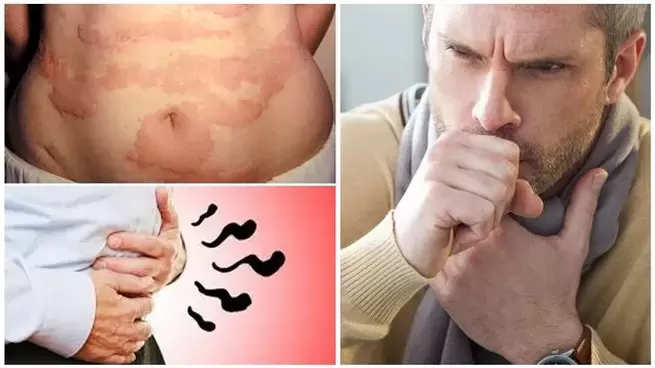Personal hygiene has significantly improved in the past century, but the problem of worms is still relevant not only for rural residents, but also for urban residents. Statistics clearly show the risk of invading helminthic infections: every third person on the planet suffers from helminthiasis. But this disease does not always manifest itself clearly, and in some cases patients cannot correctly interpret the symptoms and remain in the dark for a long time without taking any measures. Questions about how to understand that you have worms occur in helminthiasis and other pathologies with similar symptoms.

Worms are an extensive group of parasitic worms, whose main signs of presence in the human body are similar to each other. Doctors believe that every person has been exposed to helminthiasis at least once in their life. Moreover, the presence of helminths in the body can cause the development of other diseases, sometimes very dangerous, so the question of diagnosing this disease is very important.
Mechanisms of infection
Worm infection occurs in four main ways:
- Water, earth or sand. Soil and water provide ideal conditions for storing parasite eggs. A person bathing in open water is always in danger of swallowing eggs, which later turn into adults. Not as infrequently as it seems, people also swallow particles of earth, exposing themselves to the danger of infection. Certain types of parasites can enter the body directly through the skin.
- Food.Worm eggs can be found on the shell of fruits and vegetables that have not been washed or cooked properly. Consumption of raw or lightly processed meat, dried fish, dairy products, etc. it is associated with no less risk.
- Contact with the patient. Direct contact can occur with both a sick person and an infected animal. Joint activities, living in a common space, close communication contribute to the rapid entry of parasites into the intestine and its further development.
- Bites.Worms can be transmitted by insect bites. This is one of the rarest ways of infection in temperate latitudes, but it sometimes becomes the cause of the disease. In hot countries this time is more common, which should be kept in mind when going on vacation to warm countries.
Symptoms
For those who want to know how to understand that you have worms, you should understand the principles of recognizing symptoms. Any symptoms of helminthiasis do not appear immediately after the infection, but only when the parasite stops migrating through the gastrointestinal tract and begins to develop into an adult.
Some of the signs are due to the ingestion of toxins that the worm releases during life. All waste enters the lumen of the intestine, from where it is absorbed into the bloodstream and transferred to all organs. There are usually more signs and they are stronger in conditions of multiple infections, when the number of worms becomes significant. In people who are immunosuppressive or have other chronic conditions, the symptoms worsen in a relatively short period of time.

All signs are divided into two large groups: explicit and hidden. Explicit ones can be assessed independently at home, while hidden ones can only be determined on an outpatient basis with the scheduling of certain tests and examinations.
Explicit
Symptoms are obvious by which it can be understood that worms are present in the body. Their presence does not cause too obvious symptoms, as, for example, occurs with the development of the virus. The parasites are focused on life within the body, so too much aggravation of the infected host would pose a threat to their lives. For this reason, the symptoms do not require emergency care.
You may suspect or understand the presence of helminthic invasion according to the following signs:
- Gradual weight loss for no reason, lasting several months and sometimes several years in a row. The weight loss rate is not catastrophic, it is usually 2-5% per month. With a high intensity of infection in people with reduced immunity, this number can reach up to 10%.
- Gastrointestinal disorders. Some worms can block the bile ducts or intestinal lumen, causing stable constipation. With a high intensity of toxin release, on the contrary, diarrhea may recur. Inflammation of the walls of the upper part of the small intestine often causes increased bloating and flatulence, and bloating is possible.
- Severe pain in joints and muscles. Such manifestations are often attributed to the development of arthrosis, but in the case of helminths, it is caused by the migration of parasites. In addition, such pain may be due to the impact of toxins on joints and muscle tissue.
- Itching near the anus. This phenomenon is caused by the fact that a large number of species of parasitic worms crawl out of the lumen of the rectum in order to reproduce and lay eggs. It causes intense itching, which tends to get worse in the evening and at night.
- allergic manifestations. It often occurs in response to the appearance of a large number of toxins in the blood or due to damage to the intestinal mucosa, which causes an increase in the immune system and an allergic reaction.
- Pulmonary manifestations. Possible in a wide range, from constant coughing to pneumonia. Characteristic for intense ascariasis that occurs in a period of not less than three months from the moment of infection.
- Elevated temperature. Such a manifestation can be of varying intensity. Most often, a low temperature of about 37 ° C lasts for 24 hours, but in rare cases fever may be observed.

Hidden
Concealed signs can only be detected by a doctor who will adequately assess the clinical picture and be able to understand that worms are a possible cause. Preventive measures for the diagnosis of helminthiasis are:
- Analysis of earthworm feces. It must be submitted in two phases, so experts do not consider the results of one analysis reliable. This is due to the cyclical nature of reproduction, so it is far from always possible to understand from a single stool analysis that a patient suffers from helminths.
- Clinical blood test. Elevated eosinophil levels indicate that parasites are likely to be present in the body. Such an assumption often occurs after tests during the treatment or diagnosis of other diseases.
- Antibody analysis. Currently, it is one of the most reliable diagnostic methods that helps to understand whether a person has worms. Despite the fact that it is more expensive than similar drugs, lately doctors are increasingly prescribing it due to its high information and reliability.

Antiparasitic drugs or laxatives should not be taken before any clinical tests for parasites, as this complicates the diagnosis.
Signs in a child
In children, the presence of worms is diagnosed more often than in adults. Poor hygiene, close contact with domestic or street animals and incomplete development of the immune system contribute to this. A growing organism usually reacts more acutely to the presence of parasites, and the consequences may be more global than in adults. But realizing that a child has worms is not easy. The symptoms may be the same as in adults, but are usually more acute.
In most cases, the signs that indicate helminth invasion in children are:
- Fast weight loss. With the image of running, such a manifestation can lead to delays in physical development;
- Hair and nail decay. It occurs due to a long-term lack of nutrients and vitamins caused by violation of the absorption of digested food in the intestine.
- Sleep disorder. Pathology can cause a child to wake up more often at night, cry, spin and talk in their sleep.
- Irritability. Nervous system intoxication and poor health can affect the emotional state of the child, cause increased irritability, capriciousness, crying, etc.
- Desire for constant anus scratching. Children do not control external manifestations, so this symptom often helps to understand the causes of discomfort and physical changes.

Some parents tend to give their children broad-spectrum antiparasitic drugs for prevention, but experts do not recommend this because most of these drugs are quite difficult to tolerate. It is better to first understand whether the child is infected and what kind of treatment he needs, because the therapy of different types of worms differs significantly and is not always effective for helminths of other groups.






































